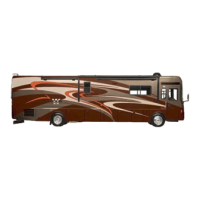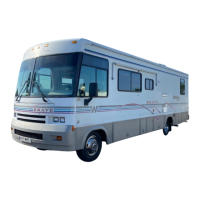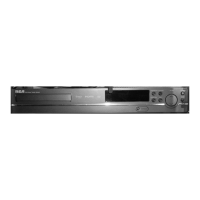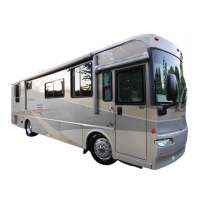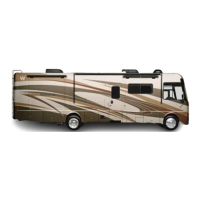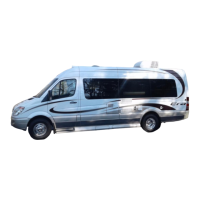
Do you have a question about the Winnebago Era Touring coach and is the answer not in the manual?
| Category | Motorhome |
|---|---|
| Manufacturer | Winnebago |
| Model | Era Touring Coach |
| Gross Vehicle Weight Rating (GVWR) | 11, 030 lbs |
| Sleeping Capacity | 2 |
| Chassis | Mercedes-Benz Sprinter |
| Horsepower | 188 hp |
| Torque | 325 lb-ft |
| Fuel Type | Diesel |
| Fuel Capacity | 24.5 gal |
| Air Conditioning | Roof-mounted |
| Engine | 3.0L V6 Turbo-Diesel |
| Generator | Onan 2.8 kW LP Gas |
Details on the purpose and scope of the operator's manual for the vehicle and equipment.
Explanation of safety terms like Danger, Warning, Caution, and Notice used throughout the manual.
Information on the dealer's responsibility for inspecting the motorhome before shipment.
Recommendations for checking and adjusting front suspension and steering alignment.
Guidance on obtaining information and assistance from dealers for vehicle operation and maintenance.
Procedure for reporting vehicle defects that could cause a crash, injury, or death to NHTSA.
Details about the label indicating vehicle occupant and cargo capacity and seat belt positions.
Information on the label affixed to the driver's area containing vehicle identification numbers.
Detailed explanation of the fields and data presented on the Vehicle Certification Label.
Technical specifications and fluid capacities for different motorhome models and chassis options.
Section for recording personal and vehicle details, including dealer and service center information.
Essential safety guidelines for operating the motorhome, including seat belt usage and seat positioning.
Key safety recommendations for driving the motorhome, covering various driving conditions and vehicle operations.
Safety precautions related to the operation and handling of the fuel and propane gas systems.
Procedures to follow if propane gas leaks are detected, emphasizing immediate safety actions.
Information about the coach's propane gas leak detector and its power connection.
Precautions and awareness regarding carbon monoxide gas from exhaust and combustion sources.
Details on the coach's carbon monoxide alarm, its function, and replacement recommendations.
Information about the smoke alarm, its power source, testing, and replacement guidelines.
Location and recommendations for inspecting the fire extinguisher for proper charge and operation.
General safety precautions for handling electrical components and systems in the motorhome.
Guidelines for securely storing loose items and understanding load limits for safe travel.
Safety precautions related to vehicle maintenance, including tire checks and fluid levels.
Information on locating and operating the emergency exit doors in the vehicle.
Details on formaldehyde emissions from interior materials and the importance of ventilation.
Guidance on preventing mold growth by managing moisture and keeping the interior clean.
Advice and precautions for handling roadside emergencies, particularly flat tires.
Information on the location and safe removal of the spare tire from its storage carrier.
Instructions and cautions for changing a wheel, referencing the chassis manufacturer's guide.
Details on alloy wheels, hub covers, and nut covers, including removal procedures.
Information on stylized chrome wheels, lug nuts, and the use of an adapter for installation/removal.
Step-by-step instructions for safely removing a wheel from the vehicle.
Precautions and actions to take if the engine is overheating, including pulling over safely.
Guidance on using the battery boost switch or jumper cables for emergency starting.
Information on adjusting the driver and co-pilot seats for individual preference and comfort.
Details on removing and installing companion seats using the quick-release pedestal system.
Step-by-step instructions for securely installing companion seats onto the floor plate.
Guidelines for proper seat belt fastening, adjustment, and care for occupant safety.
Information on selecting, installing, and using child restraint systems securely in the vehicle.
Information regarding the various keys provided for the motorhome and how to obtain duplicates.
Instructions for using the remote keyless entry system to lock and unlock doors.
Explanation of the function and use of hazard warning flashers for safety on the roadway.
Guidance on operating the dash-mounted climate controls for driver and passenger comfort.
Details on the integrated audio system, including radio, and the rearview camera monitor.
Overview of the all-in-one infotainment system offering radio, rearview monitor, and GPS capabilities.
Instructions on using the battery boost switch for emergency engine starting power from house batteries.
Important precautions and information regarding the engine's cooling system and coolant type.
Information on the location and type of fluid required for the diesel exhaust fluid fill.
Guidance on checking exterior lights for proper operation and troubleshooting bulb or fuse issues.
Instructions for accessing valve stems on front and rear wheels for tire pressure checks.
Information on the importance of proper tire pressure for handling, ride, and fuel economy.
Guidance on maintaining suspension alignment and tire balance for optimal vehicle performance and wear.
Details on the refrigerator's operation using AC, DC, or propane, and leveling requirements.
Information on accessing the exterior compartment for refrigerator inspection, maintenance, and service.
Overview of the propane-powered range top and its functions for cooking in the motorhome.
Reference to the manufacturer's user guide for complete operating instructions of the microwave oven.
Explanation of the central panel for checking utility systems like water levels, propane, and battery condition.
Details on the dual-power water heater, its operation, and safety warnings before filling.
Information regarding the pressure-temperature relief valve on the water heater and its function.
Instructions for starting up, operating, and shutting down the propane gas furnace for heating.
Operation of the heat pump feature for heating, including efficiency and temperature limitations.
Operation of the heat strip feature for supplemental heating, including efficiency and limitations.
Guidance on operating the roof air conditioning system for cooling, including vent positioning.
Recommendations for checking, cleaning, or replacing the air conditioner's washable foam filter.
Overview of the propane gas system's role in powering appliances and general safety.
Recommendation to use straight propane and avoid butane mixtures for appliance compatibility.
Troubleshooting information for appliance issues possibly caused by air in the propane gas tank.
Essential safety precautions and practices for using the propane gas system correctly.
Important warnings and regulations concerning propane gas transportation and use.
Procedures to follow if propane gas odor is detected, emphasizing immediate safety actions.
Information on the regulator's function, installation, and periodic inspection for vent blockage.
Explanation of how cold weather affects propane vaporization and potential solutions.
Critical safety warnings regarding handling electrical components and avoiding shock hazards.
Details on the 120-volt AC system, power sources, and the function of the power converter.
Information on the shoreline power cord, its location, and safe connection procedures.
Guidance on checking campground electrical protection and contacting attendants if power fails.
Explanation of the power center panel, containing circuit breakers and fuses for the house electrical system.
Information on how 120-volt AC circuit breakers protect components from overloads and shorts.
Details on the standard household electrical outlets provided for connecting appliances.
Explanation of GFCI outlets for protecting against severe electrical shock and how to reset them.
Information on the optional electrical generator and its automatic power transfer system.
Instructions for starting and stopping the generator using the switch on the Systems Monitor Panel.
Details on the hourmeter for tracking generator usage and scheduling periodic maintenance.
Overview of the 12-volt DC system, including chassis battery, house batteries, and power converter.
Reference to the Power Center section for details on the converter's function and operation.
Information on the chassis battery's role in starting the engine and powering automotive accessories.
Details on deep-cycle house batteries, their power supply, and emergency starting capabilities.
Function of the disconnect switch for preventing battery drain during storage periods.
Information on the location and access procedures for house and chassis batteries.
Essential guidelines for maintaining battery health, preventing sulfating, and ensuring proper charge.
Explanation of how 12-volt DC circuits are protected by fuses or breakers and how to reset them.
Details on the fuse panel, including amperage ratings and protected circuits for 12-volt systems.
Information on using the systems monitor panel to check the 12-volt house battery charge level.
Reference to Section 3 for information on using the battery boost switch for starting.
Details on the chassis 12-volt circuit breaker panel, including amperage ratings and protected circuits.
Overview of the fresh water system, supply sources, and methods for filling the fresh water tank.
Recommendation to use an in-line regulator to protect the fresh water system from overpressure.
Step-by-step instructions for filling the fresh water tank using the city water connection.
Explanation of how city water bypasses the pump and supplies pressure directly to fixtures.
Procedure for safely disconnecting the motorhome from an external city water supply.
Instructions for filling the fresh water tank using the gravity fill port with a water supply.
Information on the demand pump that supplies water from the tank when not connected to city water.
Step-by-step process for priming the water system and ensuring the water heater is filled.
Details on the cold water filter, its purpose, and procedures for replacing the filter cartridge.
Procedure for disinfecting the potable water system using a chlorine solution, as per NFPA standards.
Explanation of the normal water dripping from the shower hose after use.
Information on the exterior wash station feature for rinsing and bathing pets or equipment.
Details on the motorhome toilet's design and important 'don'ts' for use and disposal.
Overview of the self-contained drainage system with black and gray water holding tanks.
Step-by-step instructions for properly draining and cleaning the black and gray water holding tanks.
Guidelines for connecting to an on-site sewage hook-up while parked.
Information on the 12-volt waste pump used to dispose of holding tank waste.
Explanation of waterline and tank drain valves used for winterizing or sanitizing the water system.
Instructions on using the water heater bypass valve for easier winterization with RV antifreeze.
Detailed procedures for winterizing the water and plumbing system using compressed air or antifreeze.
Procedure for filling plumbing lines with RV water system antifreeze for winterization.
Chart detailing the locations of various drain valves for water system maintenance and winterization.
Information on the 12-volt LED TV, its power source, and operating switches.
Details on the swivel TV mechanism for watching television inside or outside the vehicle.
Instructions for angling the TV using the swivel/telescoping mechanism for optimal viewing.
Guidance on the basic operation of the coach's audio-video system components.
Information on the multi-featured audio system's DVD player and its sound output options.
Instructions on connecting and disconnecting the exterior speakers with the interior stereo system.
Operation of the digital antenna for receiving over-the-air HD channels.
Information on the TV signal amplifier, its power switch, and indicator light.
Location of the cable television input connection within the water service center.
Details on the exterior receptacle for connecting a TV and/or 12-volt device for outdoor entertainment.
Safety warning that sleeping facilities are not intended for use while the vehicle is in motion.
Instructions for converting twin beds into a full-size sleeping area by installing a cushion insert.
Step-by-step guide to converting the sofa into a bed, including securing the countertop extension.
Instructions for converting the sofa to a bed and back using the electric couch switch.
Procedure for converting the dinette area into a sleeping space, including table and leg assembly.
Information on removing and installing a removable wardrobe cabinet for extra storage space.
Instructions for lowering and raising roller shades for light filtering, darkening, or privacy.
Information on the types of hardwoods used, their characteristics, and care recommendations.
Importance of inspecting and maintaining sealants to prevent water entry and damage.
Safety warning against storing items on the roof and the importance of immediate repair of roof damage.
Recommendations for cleaning the undercarriage to prevent rust, corrosion, and unnecessary weight.
Precautions for maintaining the motorhome's gel-coated fiberglass finish, including washing and parking.
Guidelines for cleaning pressure-sensitive graphics to ensure their longevity and appearance.
Recommendations for cleaning plastic parts, starting with mildest cleaners and avoiding harsh solvents.
Instructions for cleaning exterior lamp lenses, especially headlights, and confirming operation.
Routine cleaning recommendations for fabrics and carpet to prevent dirt accumulation and wear.
Methods for cleaning wooden and vinyl cabinetry, emphasizing mild cleaners and avoiding solvents.
Care and maintenance instructions for Corian countertops, including cleaning and stain removal.
Care and cleaning instructions for the stainless steel galley sink, including stain removal.
Recommendations for cleaning vinyl flooring, including stain treatment and maintenance tips.
Reference to the toilet's information in the InfoCase for its care instructions.
Cleaning recommendations for bathroom tub and shower walls, avoiding abrasive cleaners.
Reference to Galley Sink care instructions for cleaning the lavatory sink.
Guidance on cleaning windows and maintaining door locks and hinges for smooth operation.
Essential steps for preparing the motorhome for storage to prevent damage and maintain systems.
Steps to take when removing the motorhome from storage, including system checks and cleaning.
Reference to the chassis manual for specific operating safety, service, and maintenance information.
A schedule of recommended maintenance tasks for the coach, categorized by frequency.
Guidelines for distributing cargo load equally to avoid exceeding weight ratings and ensuring safety.
Instructions on how to weigh the loaded coach at a commercial scale to check weight distribution.
Method for accurately weighing each corner of the coach to determine side-to-side weight distribution.
Information on hitch capacity, tongue weight, and general guidelines for towing vehicles or trailers.
Diagram and information on connecting trailer or tow vehicle wiring to the coach's 7-pin socket.
Key guidelines covering Gross Vehicle Weight Rating (GVWR), GAWR, and GCWR for safe towing.
Instructions for opening and closing crank-out windows, including tips to prevent glass warping.
Operation of the galley roof ventilator, including raising/lowering the dome and fan control.
Instructions for operating the bath roof ventilator, including opening/closing the dome and fan control.
Information on refilling, locking, and unlocking the vehicle's soap dispenser.
Instructions for extending and storing the slide-out compartment tray for convenient access.
Operation of the power awning and awning light, including safety notices and switch locations.
Advice on preparing for extended occupancy, addressing condensation and humidity issues.
Steps to reduce excessive moisture and condensation inside the motorhome by ventilating and minimizing moisture.

